India’s vast geography and massive population necessitate an extensive transportation network to connect its sprawling cities and remote towns. Bus travel forms the backbone of the country’s public transit system, ferrying millions of people daily between different states, cities, and villages. To support these vast bus networks, India has developed some of the largest and most advanced bus terminals in the world. These massive transit hubs service thousands of buses and millions of passengers each day, acting as crucial exchange points in India’s transportation infrastructure.
In this article, we explore the 12 biggest and most significant bus stands in India based on size, passenger volume, facilities, and overall importance to the region they serve. We trace their history and development over the years, highlight their architectural and operational features, and assess their impact on city connectivity and economic growth. For each bus stand, we also showcase some of the unique aspects that contribute to their preeminent status.
Ranking the Top 12 Biggest Bus Stands in India
1. Chennai Mofussil Bus Terminus
The Chennai Mofussil Bus Terminus (CMBT), located in the Koyambedu district of Chennai, is the largest bus stand in India and one of the biggest in Asia. Opened in 2002, it serves as the starting point for all interstate buses originating from Chennai.

Covering a massive area of 37 acres, CMBT has an annual passenger handling capacity of over 2 crore. The termini handles around 500 buses at a time catering to over 100,000 passengers daily with connectivity to over 500 destinations.
Architecturally, the CMBT features a futuristic steel-and-glass design with translucent roofs letting in natural light. Passenger facilities include AC waiting areas, restaurants, ATMs, luggage trolleys, and dormitories. The station complex also houses dedicated bus depots for major operators like TNSTC along with maintenance sheds and workshops.
With its massive scale and infrastructure, the CMBT has greatly eased congestion in Chennai’s city center while acting as a transport focal point for the entire state and southern India.
2. Delhi Sarai Kale Khan ISBT
The Sarai Kale Khan Inter State Bus Terminus (ISBT) in Delhi is one of the busiest bus stands in India, providing connectivity between Delhi and neighboring states.
Built-in 1976 across 17.5 acres, the Sarai Kale Khan ISBT handles around 200,000 passengers and over 1000 bus trips daily. There are air-conditioned waiting halls for every originating state along with restrooms, restaurants, cloakrooms, and dormitories.
In 2006, the ISBT was expanded with two large entrance plazas added along with shopping arcades. Beautification drives in 2010 also enhanced the environment with artwork and landscaping. CCTV surveillance and security systems have improved safety and operations.
With bus services to major cities in states like Uttar Pradesh, Punjab, Haryana, Himachal Pradesh, Uttarakhand, Rajasthan, and Jammu & Kashmir, the Sarai Kale Khan ISBT is integral for interstate connectivity from Delhi.
3. Hyderabad Mahatma Gandhi Bus Station
Opened in 2002, the Hyderabad MGBS is one of Asia’s largest bus terminals located in the Musheerabad area of Hyderabad. Spread over 55 acres, the station operates 24×7 and handles over 2 lakh passengers with around 800 bus arrivals/departures daily.

The terminal features an iconic twin-tower facade designed in the Deccan architectural style. Passenger facilities include large AC waiting halls, restrooms, ATMs, food stalls, and A/V systems for bus information. MGBS also houses offices and workshops for various operators like TSRTC.
Integrated transport facilities like parking areas, taxis, and auto stands make MGBS a transit hub for the city. The bus station provides connectivity to all parts of Telangana and neighboring states like Karnataka, Tamil Nadu, Odisha, and Maharashtra.
4. Kashmere Gate ISBT, Delhi
Located in north Delhi, the Kashmere Gate ISBT serves as the city’s gateway for buses to Punjab, Himachal Pradesh, and Chandigarh. Opened in 1976 on 18 acres, it handles around 160,000 passengers and over 1500 bus trips daily across its 22 platforms.
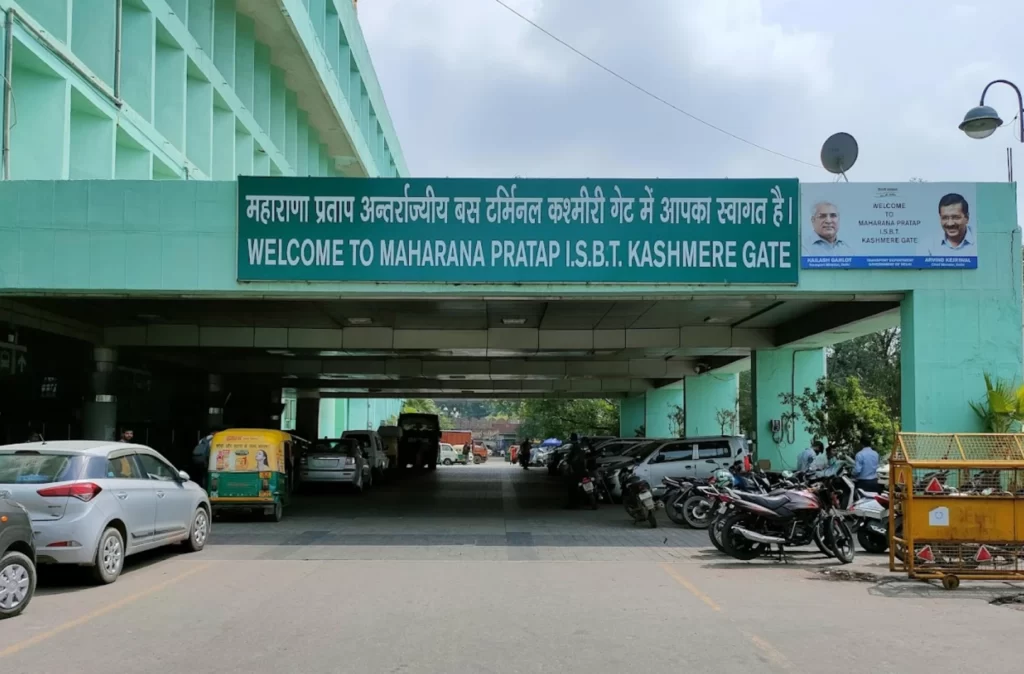
The bus station complex houses well-appointed waiting halls, dormitories, restrooms, food stalls, restaurants, and shopping areas for passengers. Medical facilities, ATMs, taxi stands, and porter services are also available within the premises.
In 2005, a modern Annexe building was built with centralized AC and large glass windows. Outdoor areas feature lawns and tree cover offering green spaces for the public. With regular upgrades and enhancements, Kashmere Gate ISBT continues to provide excellent connectivity to North Indian states from Delhi.
5. Mumbai Central Bus Terminal
Serving as the main bus station for Mumbai, Mumbai Central Bus Terminal is one of the oldest and most iconic bus stands in India. It began operations in 1950 at the site of the historic Bombay Central railway terminal.
Spread across 2.3 acres, the Mumbai Central Bus Terminal handles 700 bus departures and 200,000 passengers daily. The bus stand features a distinct colonial architectural facade with an arched entrance gate. Facilities include AC waiting rooms, dormitories, cafeterias, restrooms, cloakrooms, and shops.
Integrated with the Suburban Railway station, the bus stand provides connectivity across Mumbai and Maharashtra. Expansion plans are underway to enhance capacity, add commercial areas and improve passenger amenities. By blending an iconic design with modern amenities, Mumbai Central Bus Terminal continues to serve as the city’s main public transit hub.
6. Kempegowda Bus Station, Bengaluru
Named after Bengaluru’s founder, the Kempegowda Bus Station is centrally located in the Majestic area of the city. Built-in 1994 on 25 acres, it is managed by the BMTC and handles over 500 bus departures and 100,000 passengers daily.

The bus terminal features an elegant architectural style with arched facades and a large enclosed concourse. Amenities include waiting lounges, cloakrooms, restrooms, shopping, and food stalls. Bus services offer connectivity to all parts of Bengaluru and towns in Karnataka.
Under the SMART BUS TERMINAL project, Kempegowda Station’s intelligent transport systems for vehicle tracking and passenger information have been upgraded. An intra-city bus terminal and Metro link have also been built. As a centrally located transit hub, the bus station eases commuting for Bengaluru’s population.
7. Kolkata Esplanade Bus Station
Esplanade bus station is the largest bus depot in Kolkata and one of the oldest bus stands in India dating back to 1943. Located in the heart of the city, it operates over 100 bus routes serving metropolitan Kolkata and South Bengal.
Spread across 4 acres containing 9 platforms, the bus stand handles around 100,000 passengers daily with over 500 bus arrivals/departures. The station provides amenities like waiting rooms, rest areas, shops, and canteens for passengers.
Esplanade bus station underwent major renovation in 2010 with improvements to waiting infrastructure, bus queuing space, and walking areas. Beautification with murals and lighting was also undertaken. Further expansion plans include constructing commercial towers above the platforms. As Kolkata’s main bus transit point, Esplanade bus station continues to serve an important role in the city’s urban transportation.
8. APSRTC Bus Station, Secunderabad
Owned and operated by Andhra Pradesh State Road Transport Corporation (APSRTC), this bus station located in Secunderabad is one of the largest in South India. Spread over 15 acres, the bus station handles around 700 bus services and 150,000 passengers daily.
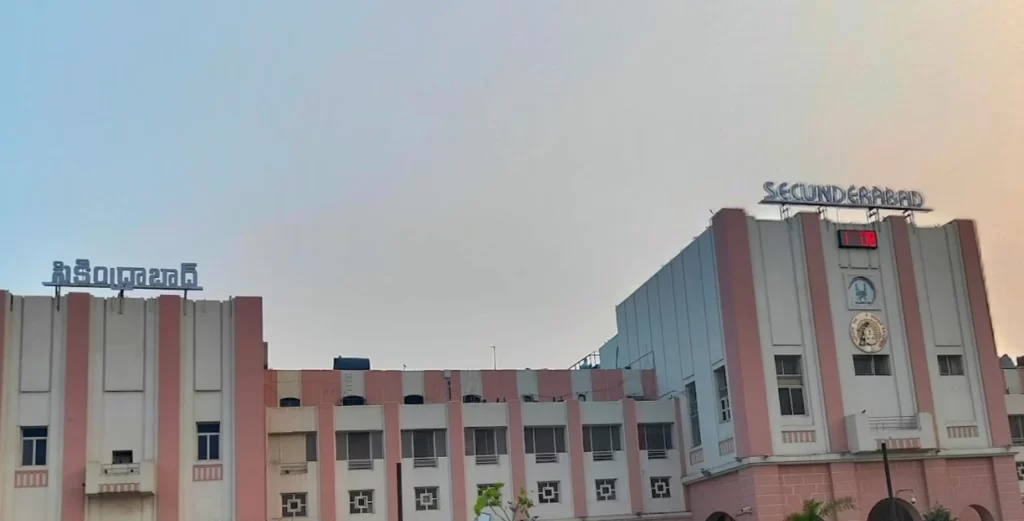
The station features an imposing architectural facade and a covered concourse longer than a kilometer. Amenities include AC waiting halls, restaurants, resting dorms, shops, ambulance services, and maintenance facilities. The bus station operates services to all 13 districts of Andhra Pradesh along with major cities such as Chennai, Bengaluru, Vijayawada, and Visakhapatnam.
In 2013, the APSRTC bus station was upgraded with the installation of hi-tech A/V passenger information systems and GPS-based vehicle tracking. With excellent connectivity across Andhra Pradesh, the Secunderabad bus depot continues to serve a vital transportation role.
9. Ahmedabad Central Bus Station
The Central Bus Station in Ahmedabad managed by GSRTC is one of the most modern bus terminals in India. Spread over 7 acres and constructed in 1990, it was designed by renowned architect B.V. Doshi. The award-winning futuristic design features soaring exposed concrete arches and passages filled with natural light.
This architectural landmark handles over 500 buses and 150,000 passengers daily. Amenities include AC waiting areas, dormitories, food stalls, restrooms, and shops. It operates regular bus services to all major cities and towns within Gujarat and neighboring states.
The Ahmedabad Central Bus Station has become a city icon that blends modernist architecture with practical functionality as a transit hub. Upcoming expansion plans envision a multi-modal transport center at the existing location.
10. KSRTC Thiruvananthapuram Bus Station
Owned by Kerala State Road Transport Corporation (KSRTC), the Thiruvananthapuram Central Bus Station serves as the main public transit hub for Kerala’s capital city. Started in the 1980s, it was substantially modernized in 2005 with a new millennium complex.
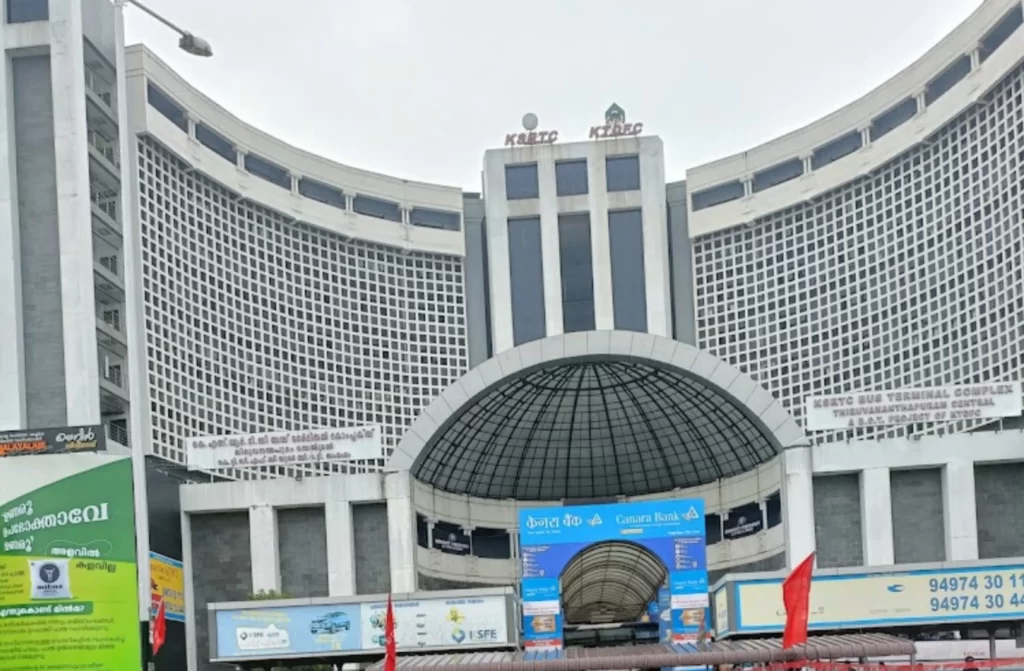
Located in the heart of the city, the bus station is spread over 36,000 sq ft and handles around 500 bus services daily. The complex includes modern AC waiting halls, restaurants, dormitories, a cafeteria, and restrooms for passenger convenience. Bus services connect Thiruvananthapuram to other major cities in Kerala and neighboring states.
In addition to the main terminus, the bus station complex houses the KSRTC headquarters, regional workshops, maintenance buildings, and dormitories for drivers and crew. With a modern design and excellent amenities, the bus station has greatly enhanced public transit in Thiruvananthapuram.
11. Gandhinagar Bus Station, Gujarat
Located in the capital city of Gandhinagar, this bus station acts as a public transit hub for the state of Gujarat. Opened in 2004, it was built at a cost of around Rs. 25 crore over 8.5 acres. The station features an imposing architectural style with wide arched roofs and expansive passenger platforms.
The bus station has a capacity of over 500 buses and serves 100,000 passengers daily. High-quality amenities include AC halls, dormitories, VIP lounges, food stalls, restrooms, and plazas. The station operates regular bus services to major intrastate and interstate destinations.
In 2019, Gandhinagar bus station added an advanced Intelligent Transport System (ITS) for passenger information and bus tracking. The hi-tech terminal with integrated transport facilities has helped transform Gandhinagar into a futuristic smart city.
12. Vijayawada Bus Station, Andhra Pradesh
Serving as the main bus transit hub of Vijayawada, this station is managed by Andhra Pradesh State Road Transport Corporation (APSRTC). Built in 1972, it is spread over 7 acres and handles over 300 bus services and 75,000 passengers daily.
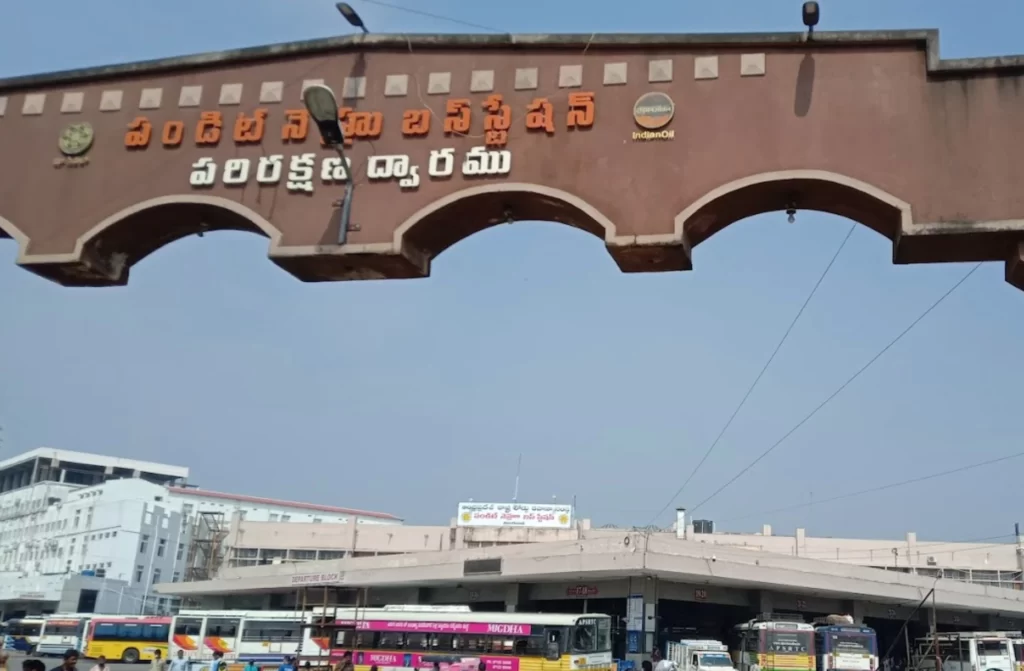
The double-storied concrete structure features an imposing pillared facade typical of 1970s architecture. Amenities include AC waiting halls, dormitories, cloakrooms, food stalls, and restrooms. Bus services connect Vijayawada to important destinations within Andhra Pradesh.
In 2020, the Vijayawada bus station was renovated under the smart city mission with upgraded amenities and facilities like purified drinking water, signage, and seating. Beautification was also undertaken along with the installation of CCTV cameras, a PA system, and mobile charging stations. As the main gateway to Vijayawada, the bus station serves an important role in the city’s transportation.
Importance of Bus Stands in India
Bus stands also referred to as bus stations or terminals, are the critical transit points that anchor India’s widespread bus networks. They provide the vital infrastructure for bus operations, allowing smooth boarding and disembarking of passengers and serving as interchange hubs for intracity and interstate transport. With Indian cities expanding rapidly and intercity connectivity improving, efficient bus stands have become indispensable to the country’s transportation system.
- Connectivity – Bus stands to connect nearby cities and states, facilitating smooth passenger transit and trade flows. They are the main transit hubs for rural populations traveling to urban centers.
- Congestion Reduction – Large, centralized bus stands reduce vehicular congestion in city centers by concentrating bus operations along mass transit corridors.
- Transport Integration – Major bus stands serve as exchange points between bus systems and other public transit modes like metros, railways, and city buses.
- Architectural Landmarks – Iconic bus terminal buildings represent major architectural achievements and city landmarks.
As India’s transportation infrastructure continues to grow, technologically advanced and passenger-friendly bus stands are crucial to improving urban mobility and connectivity across the country.
Evolution of Bus Stands in India
The bus transit system has been integral to transportation in India since the early 20th century when motorized bus services first began operations in cities like Mumbai, Chennai, and Nagpur. Over the decades, with rapid urbanization and growth in intercity travel, the bus sector expanded enormously. Bus stands evolved from small halting points along city streets to huge integrated terminals spread over large areas.
Some key milestones in the history of bus stands in India:
- Early makeshift bus stands in the 1920s-30s located along arterial city roads as bus services were introduced.
- The 1950s-60s saw planned bus stations being built with amenities like waiting rooms and rest areas as bus networks expanded.
- Bus stands were consolidated into larger terminals in the 1970s-80s in metros like Delhi and Mumbai as city bus services matured.
- Beginning in the 1990s, states invested in building modern bus terminals on the outskirts of cities to decongest urban cores.
- The 2000s saw world-class bus stands built under JNNURM and other schemes with state-of-the-art facilities.
- Ongoing upgrades to bus stands continue with amenities like solar power, EV charging, and intelligent transport systems.
The most iconic bus stands in India today are products of this evolutionary trajectory, incorporating the latest in architectural, technological, and passenger-friendly designs.
Key Features of Modern Bus Stands in India
Based on our analysis of the top bus terminals in the country, we look at some salient features of contemporary bus stand design and operations in India:
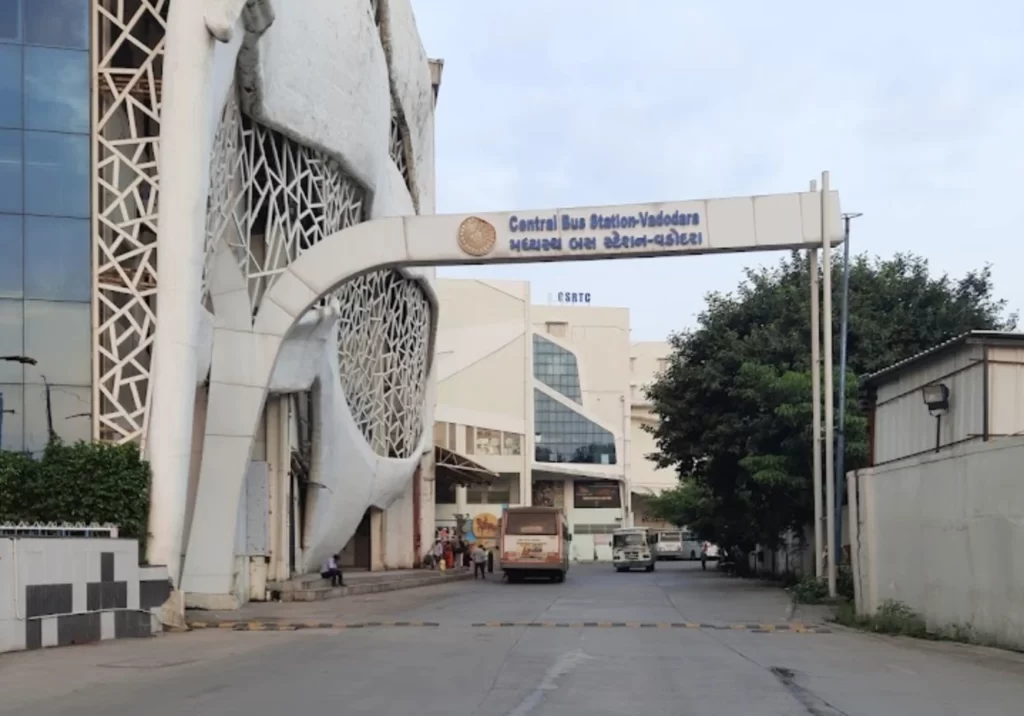
- Modern functionalist architecture with imposing facades, soaring roofs, and open interiors flooded with natural light.
- Use of traditional architectural motifs fused with minimalist contemporary elements.
- Large enclosed concourses for passenger circulation and bus docking areas.
- Air-conditioned waiting lounges with seats, TVs, and public information displays.
- Dormitories, cloakrooms, and resting areas for passenger convenience.
- Amenities like food courts, restaurants, cafeterias, and snack shops.
- Retail stores for convenience shopping for travelers.
- Security systems like CCTVs, security guards, and baggage screening.
- Integrated transit hubs with taxi stands, auto stands, and metro/railway stations.
- Intelligent Transport Systems (ITS) for bus tracking, passenger info, and operational analytics.
- Solar power, EV charging stations, and eco-friendly features.
- Public artworks and aesthetic designs to create an inviting environment.
By combining architectural grandeur with passenger-centric amenities, India’s state-of-the-art bus terminals serve as true people’s transit hubs.
Challenges Faced by Bus Stands
Despite the development of top-class facilities, bus stands in India continue to face myriad challenges that impact their functioning and service quality:
Overcrowding – Massive passenger volumes during peak hours lead to congestion and strains terminal capacity. Long queues and delays are common.
Encroachments – Unauthorized shops and parked vehicles around stations hamper circulation and access.
Inadequate Space – Constrained availability of land in cities limits expansion of existing bus stands.
Maintenance Failures – Cleanliness and upkeep of aging infrastructure remains a persistent issue.
Safety & Security – Crime, theft, and harassment incidents deter passengers, especially women.
Accessibility – Lack of facilities for disabled passengers and other inclusivity issues.
Behavior Issues – Unruly passenger behavior like queue jumping, littering, etc. due to lack of enforcement.
Traffic Congestion – Areas around bus stands prone to severe congestion due to uncontrolled vehicular movement.
Addressing these challenges through a combination of infrastructure upgrades, process re-engineering, and public awareness programs is key to enhancing the service quality of India’s bus stands.
Recent Innovations: A Look at Recent Bus Stand Upgrades
To tackle the myriad challenges plaguing bus stand operations, various stakeholders have come up with innovative solutions leveraging the latest technologies:
- Smart Terminals – Bus stations like Hyderabad MGBS and Gandhinagar are using intelligent transport systems for vehicle tracking, passenger info systems, and operational analytics to improve efficiency.
- Energy Efficiency – Stations like Chennai Mofussil and Secunderabad have installed rooftop solar power, LEDs, and rainwater harvesting to reduce environmental impact.
- Safety & Security – CCTV surveillance, panic buttons, and ladies’ special waiting areas are enhancing security for passengers. Police booths have also been set up.
- Accessibility – Inducting buses with wheelchair lifts, and adding tactile flooring, ramps, and guiding handrails are improving accessibility.
- Automation – Token-based queuing systems, electronic display boards, and automated announcements are being incorporated to aid passenger circulation.
- Mobile Apps – Apps provide real-time bus information, live tracking, booking, and cashless payments on mobiles to further assist commuters
Impact of Bus Stands on Connectivity and Economy
The massive bus stands dotting India’s transportation landscape have had a profoundly positive impact on enhancing connectivity and economic growth:
- Urban Connectivity – Large bus terminals like Kolkata Esplanade, Bengaluru Kempegowda, and Mumbai Central Bus Station have significantly improved urban mobility in metro cities by providing centralized hubs for city and intrastate bus services.
- Rural Access – Major bus stations like Chennai CMBT, Hyderabad MGBS, and Delhi Kashmere Gate connect rural citizens to urban opportunities by facilitating smooth interstate bus transit.
- Trade & Commerce – Smooth flow of people and goods between states enabled by efficient bus stands like Secunderabad and Ahmedabad boosts commerce and fuels economic prosperity.
- Affordable Transport – For lower income groups, affordable bus travel made viable by these terminals provides inclusive access to jobs, education, and healthcare.
- Transit-Oriented Development – Modern transit hubs promote the development of commercial facilities like shopping malls, food plazas, and entertainment zones in surrounding areas.
- Employment Generation – Bus stands to generate jobs for the local populace and opportunities for micro-entrepreneurs through shops and businesses catering to travelers.
The Road Ahead
With India’s bus transportation sector itself evolving through the introduction of sleeper buses, electric vehicles, and premium services, our bus stands will also continue to modernize in the future through:
- Solar-powered, zero-emission terminals with green building infrastructure.
- Use of robotics, AI, and data analytics to enhance security, operations, and energy efficiency.
- Next-gen amenities like biometric boarding gates, interactive info kiosks, and smart washrooms.
- Integration of aerial passenger ropes and skywalks for enhanced last-mile connectivity.
- Adoption of autonomous pod taxis and buses for greater first and last-mile connectivity.
- State-of-the-art command centers to monitor operations and manage advanced ITS components.
- High-speed Wi-Fi hotspots, multi-lingual interfaces, and mobile apps for a superior passenger experience.
Conclusion
India’s massive, largest bus stands like Chennai Mofussil, Delhi Sarai Kale, Hyderabad MGBS, and Ahmedabad Central serve as the vital transit hubs that anchor our nation’s widespread intercity bus network. With iconic architecture, seamless passenger amenities, and the growing adoption of smart technologies, they drive regional connectivity, urban development, and economic progress. As inclusive people’s transit spaces that touch the daily lives of millions, bus stations will continue to transform the transportation landscape and unlock opportunities for citizens across India.
So in my travels this year, the two bus stands I found particularly impressive were the Secunderabad Jubilee Bus Station which opened in March and provides excellent connectivity to southern states, and the newly expanded bus station at Pune which I visited in May that now caters to the region’s growing population with advanced amenities. Equipped with cutting-edge facilities and quintessentially Indian designs, these two terminals represent the bright future of bus travel in our country.




[…] the largest and biggest bus stands in India, connecting millions of passengers to diverse destinations across the country. From the vast […]
[…] bus stands handle the most traffic and buses in India, read our latest published post ranking the Top 12 Biggest Bus Stands in India. We have created a detailed guide to the country’s largest bus terminals and transit hubs like […]